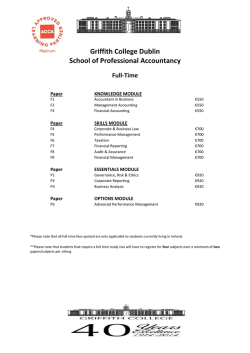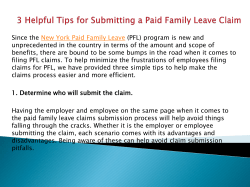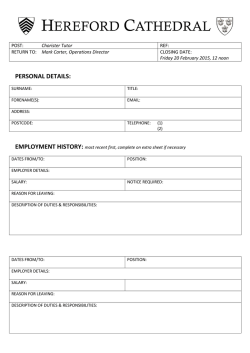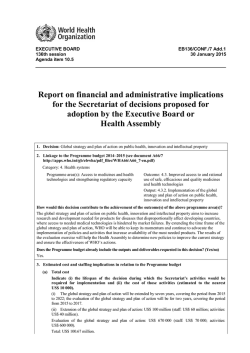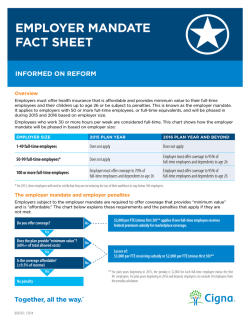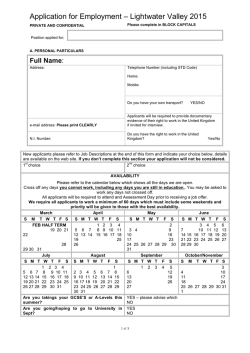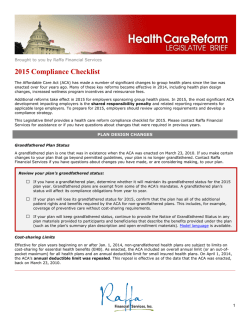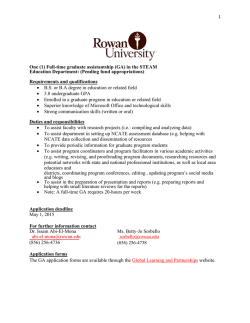
description of the provisions of hr 22, the
DESCRIPTION OF THE PROVISIONS OF H.R. 22, THE “HIRE MORE HEROES ACT OF 2015,” AS PASSED BY THE HOUSE OF REPRESENTATIVES AND REFERRED TO THE SENATE COMMITTEE ON FINANCE Scheduled for Markup By the SENATE COMMITTEE ON FINANCE on January 28, 2015 Prepared by the Staff of the JOINT COMMITTEE ON TAXATION January 26, 2015 JCX-2-15 CONTENTS Page INTRODUCTION .......................................................................................................................... 1 A. Employees with Health Coverage under TRICARE or the Veterans Administration Not Taken into Account in Determining Employers to which the Employer Mandate Applies under Patient Protection and Affordable Care Act ................................................ 2 B. Revenue Effect of the Proposal........................................................................................... 6 i INTRODUCTION The Senate Committee on Finance has scheduled a markup on January 28, 2015, of H.R. 22, the “Hire More Heroes Act of 2015,” a bill to amend the Internal Revenue Code of 1986 to exempt employees with health coverage under TRICARE or the Veterans Administration from being taken into account for purposes of determining the employers to which the employer mandate applies under the Patient Protection and Affordable Care Act, as passed by the House of Representatives and referred to the Committee on Finance.1 This document,2 prepared by the staff of the Joint Committee on Taxation, describes the provisions of the bill and provides the revenue effects. 1 Unless otherwise stated, all section references are to the Internal Revenue Code of 1986, as amended. 2 This document may be cited as follows: Joint Committee on Taxation, Description of the Provisions of H.R. 22, the “Hire More Heroes Act of 2015,” as Passed by the House of Representatives and Referred to the Senate Committee on Finance (JCX-2-15), January 26, 2015. 1 A. Employees with Health Coverage under TRICARE or the Veterans Administration Not Taken into Account in Determining Employers to which the Employer Mandate Applies under Patient Protection and Affordable Care Act Present Law Employer shared responsibility for health coverage In general Under the Patient Protection and Affordable Care Act (“PPACA”),3 as amended by the Health Care and Education Reconciliation Act of 20104 (generally referred to collectively as the “Affordable Care Act” or “ACA”), an applicable large employer may be subject to a tax, called an “assessable payment,” for a month if one or more of its full-time employees is certified to the employer as receiving for the month a premium assistance credit for health insurance purchased on an American Health Benefit Exchange or reduced cost-sharing for the employee’s share of expenses covered by such health insurance.5 As discussed below, the amount of the assessable payment depends on whether the employer offers its full-time employees and their dependents the opportunity to enroll in minimum essential coverage under a group health plan sponsored by the employer and, if it does, whether the coverage offered is affordable and provides minimum value. Under the ACA, these rules are effective for months beginning after December 31, 2013. However, in 2013, the Internal Revenue Service (“IRS”) announced that no assessable payments will be assessed for 2014.6 In addition, in 2014, the IRS announced that no assessable payments for 2015 will apply to applicable large employers that have fewer than 100 full-time employees and full-time equivalent employees and meet certain other requirements.7 3 Pub. L. No 111-148. 4 Pub. L. No. 111-152. 5 Sec. 4980H. This is sometimes referred to as the employer shared responsibility requirement. An applicable large employer is also subject to annual reporting requirements under section 6056. Premium assistance credits for health insurance purchased on an American Health Benefit Exchange are provided under section 36B. Reduced cost-sharing for an individual’s share of expenses covered by such health insurance is provided under section 1402 of PPACA. For further information on these provisions, see Part III.B-D of Joint Committee on Taxation, Present Law and Background Relating to the Tax-Related Provisions in the Affordable Care Act (JCX-6-13), March 4, 2013, available at www.jct.gov. 6 Notice 2013-45, 2013-31 I.R.B. 116, Part III, Q&A-2. 7 Section XV.D.6 of the preamble to the final regulations, 79 Fed. Reg. 8544, 8574-8575, February 12, 2014. 2 Definitions of full-time employee and applicable large employer For purposes of applying these rules, full-time employee means, with respect to any month, an employee who is employed on average at least 30 hours of service per week. Hours of service are to be determined under regulations, rules, and guidance prescribed by the Secretary of the Treasury (“Secretary”), in consultation with the Secretary of Labor, including rules for employees who are not compensated on an hourly basis. Applicable large employer generally means, with respect to a calendar year, an employer who employed an average of at least 50 full-time employees on business days during the preceding calendar year.8 Solely for purposes of determining whether an employer is an applicable large employer (that is, whether the employer has at least 50 full-time employees), besides the number of full-time employees, the employer must include the number of its full-time equivalent employees for a month, determined by dividing the aggregate number of hours of service of employees who are not full-time employees for the month by 120. In addition, in determining whether an employer is an applicable large employer, members of the same controlled group, group under common control, and affiliated service group are treated as a single employer.9 Assessable payments If an applicable large employer does not offer its full-time employees and their dependents minimum essential coverage under an employer-sponsored plan and at least one full-time employee is certified as receiving for the month a premium assistance credit or reduced cost-sharing, the employer may be subject to an assessable payment of $2,00010 (divided by 12 and applied on a monthly basis) multiplied by the number of its full-time employees minus 30, regardless of the number of full-time employees so certified. For example, in 2016, Employer A fails to offer minimum essential coverage and has 100 full-time employees, 10 of whom receive premium assistance credits for the entire year. The employer’s assessable payment is $2,000 for each employee over the 30-employee threshold, for a total of $140,000 ($2,000 multiplied by 70 (100-30)). 8 Additional rules apply, for example, in the case of an employer that was not in existence for the entire preceding calendar year. 9 The rules for determining controlled group, group under common control, and affiliated service group under section 414(b), (c), (m) and (o) apply for this purpose. If the group is an applicable large employer under this test, each member of the group is an applicable large employer even if any member by itself would not be an applicable large employer. In addition, in determining assessable payments (as discussed herein), only one 30-employee reduction in full-time employees applies to the group and is allocated among the members ratably based on the number of full-time employees employed by each member. 10 For calendar years after 2014, the $2,000 dollar amount, and the $3,000 dollar amount referenced herein, are increased by the percentage (if any) by which the average per capita premium for health insurance coverage in the United States for the preceding calendar year (as estimated by the Secretary of Health and Human Services (“HHS”) no later than October 1 of the preceding calendar year) exceeds the average per capita premium for 2013 (as determined by the Secretary of HHS), rounded down to the nearest $10. 3 Generally an employee who is offered minimum essential coverage under an employer-sponsored plan is not eligible for a premium assistance credit or reduced cost-sharing unless the coverage is unaffordable or fails to provide minimum value.11 However, if an employer offers its full-time employees and their dependents minimum essential coverage under an employer-sponsored plan and at least one full-time employee is certified as receiving a premium assistance credit or reduced cost-sharing (because the coverage is unaffordable or fails to provide minimum value), the employer may be subject to an assessable payment of $3,000 (divided by 12 and applied on a monthly basis) multiplied by the number of such full-time employees. However, the assessable payment in this case is capped at the amount that would apply if the employer failed to offer its full-time employees and their dependents minimum essential coverage. For example, in 2016, Employer A offers minimum essential coverage and has 100 full-time employees, 20 of whom receive premium assistance credits for the entire year. The employer’s assessable payment before consideration of the cap is $3,000 for each full-time employee receiving a credit, for a total of $60,000. The cap on the assessable payment is the amount that would have applied if the employer failed to offer coverage, or $140,000 ($2,000 multiplied by 70 (100-30)). In this example, the cap therefore does not affect the amount of the assessable payment, which remains at $60,000. TRICARE and veterans health programs The Military Health System provides active and retired members of the armed forces and their families (including certain survivors and former spouses) with medical coverage, primarily through the TRICARE program.12 The TRICARE program offers various health plans, including a managed care option and fee-for-service options.13 The Veterans Health Administration (“VHA”), within the Department of Veterans Affairs, provides certain veterans and family members (including certain survivors) with medical coverage through its health care programs.14 Enrolled veterans are provided with a range of medical benefits, including inpatient, outpatient, and preventive services. Medical coverage for eligible family members of veterans is provided through the Civilian Health and Medical Program (“CHAMPVA”). 11 Under section 36B(c)(2)(C), coverage under an employer-sponsored plan is unaffordable if the employee’s share of the premium for self-only coverage exceeds 9.5 percent of household income, and the coverage fails to provide minimum value if the plan’s share of total allowed cost of provided benefits is less than 60 percent of such costs. 12 10 U.S.C. chapter 55. Health care may be provided through military treatment facilities or private health care providers. 13 Information about the TRICARE program is available at http://www.tricare.mil/. 14 38 U.S.C. chapters 17 and 18. Veterans are enrolled in VHA health care programs based on specified priority categories. The highest priority is given to veterans with a service-connected disability. Information about VHA health care programs is available at http://www.va.gov/health/. 4 Description of Proposal Under the proposal, solely for purposes of determining whether an employer is an applicable large employer for any month, an individual is not taken into account as an employee for the month if the individual has medical coverage for the month under (1) a program for members of the armed forces, including coverage under the TRICARE program, or (2) under a VHA health care program, as determined by the Secretary of Veterans Affairs, in coordination with the Secretary of Health and Human Services and the Secretary. Effective Date The proposal applies to months beginning after December 31, 2013. 5 B. Revenue Effect of the Proposal The following presents the estimated Federal fiscal year budget effects of the proposal. Fiscal Years [Millions of Dollars] 2015 2016 2017 2018 2019 2020 2021 2022 2023 2024 2025 2015-20 2015-25 --- -64 -68 -72 -77 -82 -88 -93 -99 -104 -110 -364 -858 NOTE: Details do not add to totals due to rounding. Source: Estimate provided by the staff of the Joint Committee on Taxation and the Congressional Budget Office. 6
© Copyright 2026
